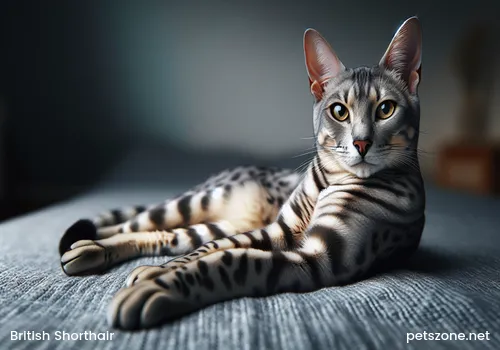Differences between British Shorthair and Russian Blue Cats_7 Major Differences Between British Shorthair and Russian Blue Cats
If you are looking for a blue short-haired cat as a new family member, you will likely hesitate between a British Shorthair (Brit Shorthair) and a Russian Blue. Although they both have charming blue-gray coats, these two “blue friends” actually have significant differences in many aspects. Understanding these differences can help you find the "meow star" that suits you best. Simply put, the Brit Shorthair blue cat is round-bodied and steady-tempered, known as the adorable “blue chubby”; while the Russian Blue cat is slender with a relatively shy personality, the elegant and mysterious “winter sprite.”
Although both British Shorthairs and Russian Blues are known for their blue-gray coats, they are completely different breeds. Their differences are not only reflected in appearance but also in personality, origin, and even price. Below, we detail seven aspects to help everyone “discerningly recognize cats.”

1. Appearance Features: One is “round” and the other is “slim”
This is the most intuitive point to distinguish between Brit Shorthair and Russian Blue cats.
- British Shorthair: The first impression of a Brit Shorthair is chubby and plump. They have round and broad faces with a distinctive “bun face,” and a short thick neck. Their bodies are solid and compact, with broad chests, short and strong limbs, and relatively short tails with thick bases and rounded tips. Overall, Brit Shorthairs fit the image of an adorable “blue chubby.” Their eyes are large and round with varied colors, mostly gold, copper, or orange.
- Russian Blue: The Russian Blue is completely different in style, with a slender build and fine bones, appearing elegant and light. The head is medium wedge-shaped, with a refined face lacking the chubby cheeks of a Brit Shorthair. Their limbs are long, paws small and round, almost tiptoeing when walking, showing noble temperament. Their ears are large and upright with pointed tips, set relatively high. Eyes are almond-shaped, usually bright emerald green, forming a striking contrast with the blue-gray coat, very charming.
2. Coat Characteristics: Texture and Gloss Both Unique
Though both have blue coats, their feel and sheen differ.
- British Shorthair: Brit Shorthair fur is short and dense, feeling like thick velvet, very soft and comfortable. Their coat colors are diverse; blue is only one option, alongside black, white, cream, red, and solid colors, as well as bicolor, shaded, tabby and other patterns.
- Russian Blue: The Russian Blue’s coat is also short and dense but with a finer texture and a unique sheen that shines with a silver glow under light, earning them the nickname “Winter Sprite.” The classic color is unique blue-gray with silver-tipped fur. Although some associations recognize white and black Russian Blues, the most well-known are blue.
3. Personality Traits: One is “steady” and the other “sensitive”
Cat personality is an important factor when choosing a pet.
- British Shorthair: Brit Shorthairs are usually gentle, steady and calm. They adapt well and aren’t very sensitive to environmental changes. They enjoy being close to people but are not overly clingy and can be independent. Brit Shorthairs tend not to be very vocal, have quiet temperaments, making them very suitable for families, especially those with children or other pets. They are intelligent, easy to train, and loyal to their owners. Some still retain excellent hunting abilities from their ancestors.
- Russian Blue: Russian Blues tend to be quieter, shy, even somewhat wary. They dislike noisy environments and prefer quiet, stable home lives. They trust their owners deeply, are affectionate and gentle, enjoy pleasing their owners, and are very loyal. They can live peacefully with other pets but tend to be cautious with strangers and may need time to adjust. Their meows are soft and sweet, rarely loud, sometimes so quiet that novice owners may not notice even during heat cycles. They’re very intelligent, empathetic, observant, and interested in toys, sometimes described as the “wise man” of cats. Notably, they are very devoted to their owners and may follow them everywhere.
4. Body Size and Weight: Who Is the True “Heavyweight”?
Cat size also affects space requirements for care.
- British Shorthair: British Shorthairs are medium to large cats with round and solid physiques. Adult males outweigh females considerably, typically between 4.1 to 7.7 kg, females between 3.2 to 5.4 kg. Some Brits can even reach 8 kg. Their size and weight make them look like small “teddy bears.”
- Russian Blue: Russian Blues are medium-sized with slender forms. Adult Russian Blues average about 3.5 to 7 kg. Generally, Russian Blues are lighter than Brit Shorthairs. Male cats are usually bigger than females.
5. Health Conditions: Genetic Diseases
Knowing potential health issues is very important for caretakers.
- British Shorthair: Brit Shorthairs are generally healthy but prone to obesity due to genetics. Excessive weight can cause problems like heart disease and kidney disorders. Common genetic diseases include Polycystic Kidney Disease (PKD) and Hypertrophic Cardiomyopathy (HCM). Regular ultrasound and heart check-ups are recommended.
- Russian Blue: Russian Blues are generally healthy with fewer genetic issues, so they rarely get sick. Their average lifespan is usually 15 to 20 years, with some living up to 25, which is considered long for cats.
6. Price: Whose “Value” Is Higher?
Price is a practical factor many consider when choosing a pet.
- British Shorthair: Brit Shorthair prices depend on factors like coat color, pedigree, appearance, and purchase channels. Ordinary Brit Shorthair blue cats usually cost around 2000 RMB, good-quality purebreds might reach 5000 RMB or more, and exceptionally fine specimens can go up to 8000-10000 RMB. Rare colors like silver shaded, golden shaded cost even more; top-quality golden shaded may exceed 10,000 RMB.
- Russian Blue: Compared to Brits, purebred Russian Blues are relatively rare domestically and considered “in high demand.” Therefore, purebred Russian Blue prices are generally higher than British Blues. Ordinary Russian Blue kittens are about 4000 RMB, good-quality ones above 5000 RMB. Buying purebred Russian Blues often requires importing them, with prices running into tens of thousands or even more.
7. Origin History: From Britain or the Northern Country?
Understanding a cat’s origin helps better comprehend their characteristics.
- British Shorthair: British Shorthair is one of the oldest breeds in Britain, dating back to the 1st century AD when Romans brought Egyptian cats to Britain and bred them with local cats. In the late 19th century, the breed was formally established and first appeared at the 1871 London Crystal Palace exhibition. They were originally bred to catch mice.
- Russian Blue: Russian Blue is a naturally occurring breed originating from the port area of Arkhangelsk, Russia, hence initially called Arkhangelsk Blue. They may have been brought to England by ships in the 17th century. Their ancestors lived in cold Siberia, so they developed strong cold resistance. The population sharply declined during World War II and was later restored through crossbreeding with other breeds (including Siamese), which introduced some oriental traits in Russian Blues.
Frequently Asked Questions
Q1: Which is more suitable for beginners, British Blue or Russian Blue?
Both are quite suitable for home keeping, but if you prefer quiet, less active cats who are cautious of strangers, Russian Blues may be better. If you want a relatively independent cat that adapts well and doesn’t require much attention, British Blues are also a good choice.
Q2: Are British Blue cats only blue?
No. British Shorthairs come in many colors and patterns; blue is just the most popular and common.
Q3: Do Russian Blue cats shed a lot?
Compared to some long-haired cats, Russian Blues shed less, and their coats are less prone to matting, making daily care easier.
Q4: Which has less body odor, British Blue or Russian Blue?
Generally, cats don’t have strong body odor. As long as they are kept clean, litter boxes are regularly cleaned, and diet is healthy, body odor is minimal.
Q5: How to tell if a blue cat is a purebred British Shorthair or Russian Blue?
The most reliable method is to check the cat’s pedigree certificate. Without certificates, you can judge comprehensively by appearance, body type, face shape, eye color, ear shape, and consult experienced breeders or veterinarians.
Q6: What is the average lifespan of British Blue and Russian Blue cats?
The average lifespan of British Blue is between 12-20 years, and Russian Blue between 15-20 years. Scientific feeding and attentive care can help them live longer.
Summary
Overall, although both are “blue cats,” British Shorthair and Russian Blue are very different breeds. The Brit Shorthair is like a sincere and sturdy “little bear” who enjoys a quiet and comfortable life; Russian Blue is like an elegant and mysterious “little fairy,” smart and affectionate. Your choice depends on your personal preference and lifestyle. Hopefully, this detailed comparison helps you find that destined “blue friend”!
References
Russian Blue - Wikipedia, the Free Encyclopedia
Russian Blue vs. British Shorthair: What's the Difference? | Via Emilia
【British Shorthair】Why Brit Shorthairs Are Prone to Obesity? Personality, Genetic Diseases and Care - Furmomo (2024-12-11)
Russian Blue_Cats - Mengdog Website
What Is a British Shorthair Blue Cat? Breed Characteristics, Personality and Care Analysis - Stinky Cat Zoo (2025-02-05)
How Much Does a Russian Blue Cat Cost? How to Choose a Russian Blue? - Waifang Website (2018-06-19)
British Shorthair vs Russian Blue Cat: What Are The Key Differences? - A-Z Animals (2024-10-17)
What is the difference between a Russian blue and a British blue cat? - Quora (2021-06-15)
British Shorthair Four Major Care Points, Breeding Methods, Breed Characteristics
Difference between a British Shorthair, Russian Blue, Korat, and Chartreux - Kitty in NY
Russian Blue vs. British Shorthair: Differences Explained (With Pictures) - Hepper (2025-03-24)
Russian Blue VS Siamese Cat (Detailed Comparison)_Cats - Mengdog Website
How Much Is a Russian Blue Cat? - Mengdog Website (2020-04-03)
British Shorthair Breed Introduction - Pet Doctor
How Much Is a Russian Blue? Russian Blue Cat Price - Daddy Du - Mengdog Website (2021-03-15)
British Shorthair Personality Characteristics - Bull Pharmaceuticals
Russian Blue Personality Analysis: The Winter Sprite Descended to Earth_Overseas Real Estate News_Overseas Property ...
How Russian Blues Are Gentle and Liked by Many - Sina (2017-12-23)
Cat Science Popular: All Blue Cats, What Are the Differences Between Russian Blue and British Blue? - Sina (2020-04-10)
Knowledge Boost: Brit Shorthair Has Over 40 Varieties, But Prices Vary Greatly? - Sina (2019-07-08)
How Much for a Purebred British Shorthair Cat? Teach You Some Tips - NetEase (2023-05-19)
Purebred Brit Shorthair!!|Pet|British Shorthair - NetEase (2022-09-20)
The Same Blue Cats, How to Distinguish British Blue and Russian Blue? (2023-05-30)
British Shorthair - Cat Fan
Difference Between Russian Blue and Brit Shorthair to Teach You How to Recognize Cats! - NetEase (2018-05-07)
Are Russian Blue and Other Blue Short-Haired Cats the Same? - Cat News Channel - Cat Website (2023-02-16)
Silver Shaded Cat Market Price (How Much Silver Shaded Cats Cost) - Pet Franchise (2023-07-11)
Blue Cats Are Not Just Brit Shorthairs, This Blue Cat Is Generally Unaffordable, Famous for Being Expensive - Sina (2019-06-18)
One World, Different Blue Cats—How to Choose the Blue Cat That Suits You Best - NetEase (2019-01-09)
Differences, Prices and Care of British Shorthair and Blue Cats - Home Pets - Lin’an 19 Lou Mobile (2019-08-01)
How Much Does a Blue Cat Cost? 10 Key Points on How to Raise a Blue Cat - NetEase (2020-12-18)
Russian Blue Cat Price, Personality and Care Guide: Complete Guide for Beginners - Stinky Cat Zoo (2025-01-11)


-560x560.webp)
